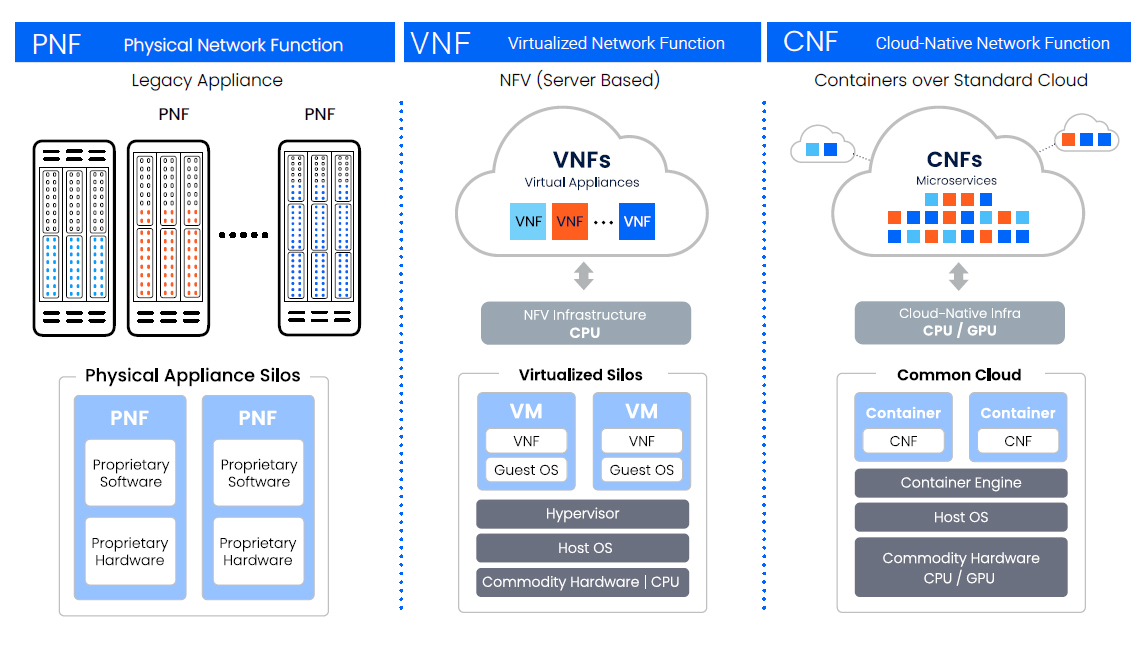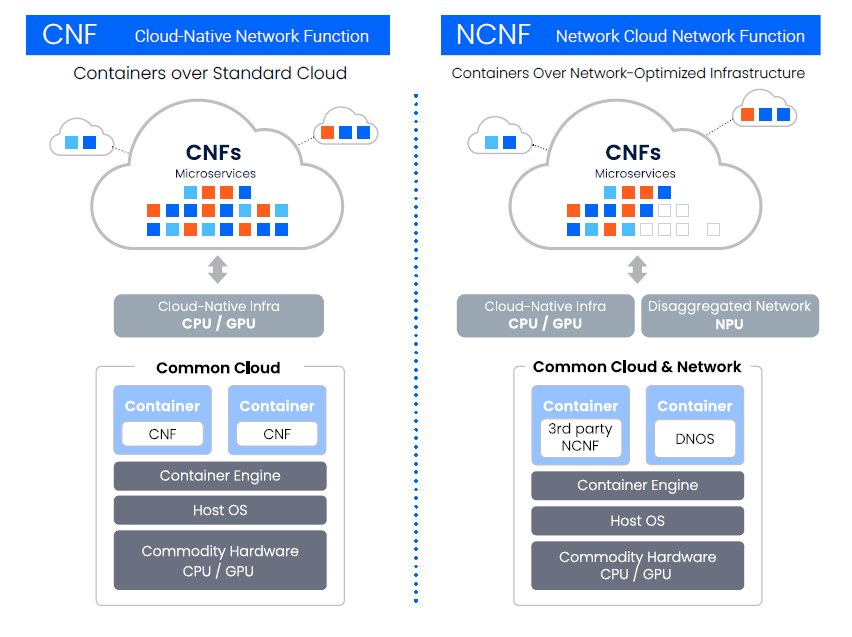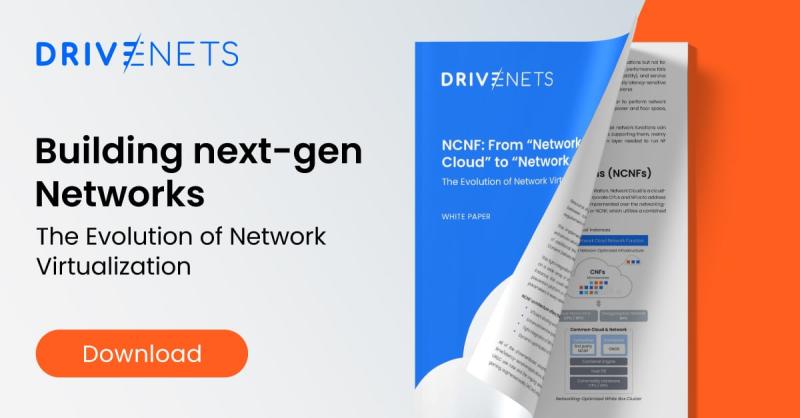What Is Cloud-Native Networking?
Cloud-native networking is an approach to building and deploying network functions using cloud-native architecture. Traditional networks typically rely on physical network functions (PNFs), which are dedicated hardware appliances that also encapsulate a fixed software functionality. For example, a monolithic router combines hardware and software in a fixed box. In some cases, networks use virtual network functions (VNFs), where multiple software functionalities can run on a virtual machine.
Cloud-Native Network Functions (CNFs)
Cloud-native networking, on the other hand, leverages cloud-native network functions (CNFs). These CNFs are built using containerized microservices running on shared hardware. This approach offers greater elastic scalability and software agility due to more advanced management and orchestration capabilities.

Why Do We Need Cloud-Native Networking?
Service providers (SPs) today often build their networks using traditional networking solutions, which involve PNFs and in some cases VNFs. Using these functions leads to manual configurations, static architectures, and inflexible orchestration models, which can hinder scalability, agility and cost efficiency. As a result, many SPs are limited in their ability to scale due to pre-determined chassis hardware, and they are also slow to introduce new services.
Data centers faced the same problems as SP networks: complexity, low utilization due to pre-determined chassis, dedicated servers for each service, and never-ending software updates. Data centers were a nightmare to operate, scale and support.
Cloud providers solved this problem by using CNFs. Moving to cloud-native networking, cloud providers were able to streamline hardware, treating it as a pool of computing and storage resources while deploying the software above in multiservice containers. Moreover, they developed software to manage and scale resources and services. As a result, cost savings and flexible scalability were achieved as part of their cloud-native transformation.
Core Benefits of Cloud-Native Networking
- Automation and simplified management: Cloud-native networking leverages automation to manage network configurations, scaling, and maintenance. Automation is achieved through end-to-end software-defined orchestration, and rich northbound interfaces, such as APIs and NETCONF. Using these capabilities allows SPs to reduce the need for manual intervention and enables more efficient network operations.
- Seamless Development: Cloud-native networking is designed to support containerized microservices software This isolated, air-gapped, software architecture ensures that developers can scale, update and operate services without affecting ongoing performance.
- Scalability and flexibility: Cloud-native networking, with its granular microservices nature and virtually limitless compute storage and networking resources, can offer a true elastic network. Such a network can flexibly resize its network resources in response to real-time network demands, offer improved performance and user experience, and reduce costs for SPs.
- Rapid service delivery: By automating network operations and supporting containerized microservices architecture, cloud-native networking enables service providers to deploy and update services more rapidly.
Challenges of Cloud-Native Networking
Cloud-native networking, while offering numerous benefits like simplicity, flexibility and service agility, also comes with its own set of challenges. Understanding and addressing these challenges is crucial for SPs who are looking to implement this network architecture.
Its main challenges include:
- Complexity: Cloud-native networking presents a paradox. On the one hand, it simplifies management through automation, significantly reducing the effort required to manage large-scale networks. On the other hand, as networks become more dynamic, distributed and granular, they also become more complex to operate. The primary challenge lies in properly supporting this complex environment, necessitating expertise in Kubernetes, containers, microservices, and other cloud-native technologies – skills not commonly possessed by traditional network operations teams.
- Integration: Integrating cloud-native networking solutions with existing legacy infrastructure presents challenges, often requiring significant effort to achieve seamless network operations. This is a common challenge encountered when adopting any new technology and necessitates careful planning and execution.
- Monitoring and troubleshooting The distributed and granular nature of cloud-native architectures can make it difficult to gain comprehensive visibility. Troubleshooting issues across multiple services can also be time-consuming.
- Cost: To reap the full benefits of elastic scalability and service agility, which include real-time response to market demands, SPs must continuously optimize resource usage and manage costs effectively. This ongoing process requires advanced tools and expertise.
Cloud-Native Networking and DriveNets
Managing large-scale networks brings service providers face-to-face with the same challenges that pushed cloud providers to embrace cloud-native networking. Both are in search of a solution that is flexible, scalable, and simpler to operate. To solve those challenges cloud providers tried VNFs, which did not provide a complete solution. NFVs are still hard to scale, leading to the adoption of CNFs that are highly scalable. However, for SPs with demanding routing needs, CNFs fall short. The hardware underlying CNFs isn’t optimized for advanced routing functions, making them more suitable for data center deployments.
DriveNets Network Cloud goes beyond VNFs and CNFs. Unlike CNFs in cloud providers’ data centers, DriveNets Network Cloud utilizes cloud-native software to manage a combined pool of classic compute resources (CPUs/GPUs) and network-specific compute resources (NPUs). This empowers the creation of any advanced routing function, from core to edge, by selecting the optimal compute resources while preserving the advantages of cloud-native networking.

DriveNets Network Cloud enables service providers to solve their main challenges of vendor diversity, flexibility, and fast service delivery with a cloud-native solution that is also suitable for large-scale networks with advanced routing requirements.
Read more about how to build your network like cloud.
Key Takeaways for Service Providers
Cloud-native networking represents a significant transformation in how service providers can build their modern network infrastructure. By embracing cloud-native principles, SPs can move away from manual configurations, rigid architectures, and inflexible orchestration models. This shift enables simpler and more automated network operations, faster service delivery, and more efficient resource optimization.
This approach, simply, empowers service providers to regain control over their networks.
Additional Cloud-native Networking Resources
- Transforming Network Infrastructure: DIGI deploys DriveNets Network Cloud
- How the Telecom Industry Can Regain Its Innovative Edge
- Our Hands-on Networking Experience
- Network Disaggregation Shifts the Balance of Power to Service Providers
- How White Box Networking Makes Service Providers More Versatile
- Why Service Providers Are Rethinking Network Architecture






